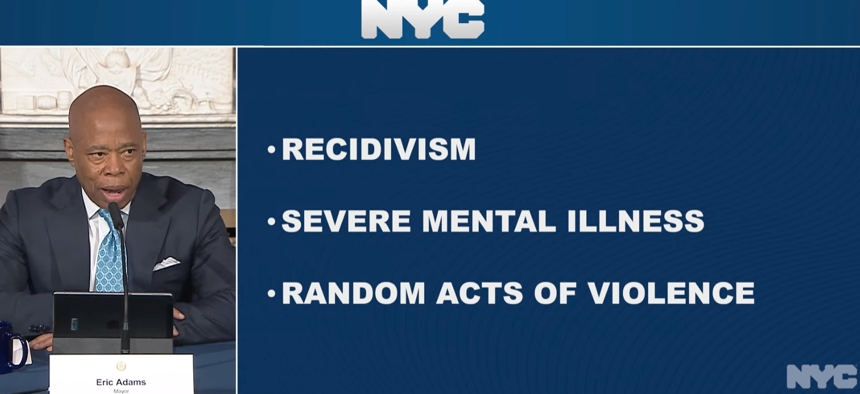Eric Adams
Adams rings public safety alarm bells, but says city is not “out of control”
The killings of an NYPD officer and an individual on the subway tracks on Monday pointed to a trio of public safety issues for the city, according to the mayor.

New York City Mayor Eric Adams identified three major problems facing the city. Screenshot/New York City
New York City Mayor Eric Adams’ weekly off-topic press conference started off in somber silence on Tuesday, as the mayor and his top administration officials recognized Jonathan Diller, a 31-year-old New York City police officer who was killed on Monday during a traffic stop in Queens.
“It’s just a senseless act of violence,” Adams told reporters.
The same evening, an individual on the subway platform at the 125th Street stop on Lexington Avenue in East Harlem was killed after being pushed onto the tracks in what appeared to be an unprovoked attack.
Adams said the violence pointed to a core set of problems facing the city: recidivism, severe mental illness and random acts of violence. Adams noted that the two men who were stopped by Diller and his partner, including the accused shooter, had a long list of prior arrests. Adams also called the man charged with murder in the subway pushing a “recidivist” who had severe mental health issues.
Laying out that trio of deep-rooted issues, Adams walked a fine line between making the case for taking more aggressive action to tackle them, and beating back a narrative, as he put it, that crime in the city is “out of control.”
“What’s interesting is that our practices, laws and policies are not going after those three issues,” Adams said. “We are up in Albany right now fighting to put teeth to Kendra’s Law so we can institute a process of removing those who are a danger to themselves and others,” he added, referring to the administration’s efforts to expand the state law that enforces court-ordered Assisted Outpatient Treatment for people with serious mental illness. Adams said his director of the Office of Intergovernmental Affairs, Tiffany Raspberry, has been in Albany “pounding away at this piece of legislation.”
Adams characterized the people committing acts of violence in the city as having a total disregard for their actions. “These are bad people who are doing bad things to good people,” Adams said. “It’s the good guys against the bad guys.”
But just after sounding those alarms, Adams sought to quiet others. “When we highlight the severe acts of violence on social media, these random acts of violence, it just makes people afraid,” Adams said. “We hear this over and over again – ‘the city is out of control, the city is out of control, the city is out of control.’ It’s just not true. That’s why we keep saying crime is down (and) jobs are up.”
At the press conference, Adams pointed to a statistic that subway crime has decreased 5.6% since he became mayor. Last year, overall crime in the system fell over the previous year even as the number of riders grew, The New York Times reported. But there was a spike in major crimes in the subway system in January.
“We have to push back on this narrative that we are living in a city that’s out of control,” Adams said. “I know a city that is out of control because I’ve visited some of them in this country. This is not one of them.”
But Adams, who ran on promises to fight crime, has found himself walking the line of highlighting concerns about crime and advocating for tools to tackle it, while also beating back the “out of control” rhetoric. He toed it again on Tuesday when referencing challenges with recruiting and retaining police and other law enforcement personnel. “The foundation of the public safety apparatus is dissolving right in front of our eyes,” he said, before cutting that bold statement with the suggestion that that dissolution isn’t yet complete. “If we don’t get in front of it, we are going to be dealing with a severe public safety crisis that other cities are experiencing. That is the concern, that is the clarion call we must put out.”
Adams’ comments came as the city has flooded hundreds more officers into subway stations this week to combat fare evasion, while Gov. Kathy Hochul announced several weeks ago the deployment of state troopers and National Guard troops in the system after a few high-profile attacks.
Violent crime in the subways is still rare, but some polls and surveys have shown that New Yorkers feel less safe – both inside and outside the subway system. A recent survey by the Citizens Budget Commission found that 78% of New Yorkers feel unsafe riding the subway at night.

